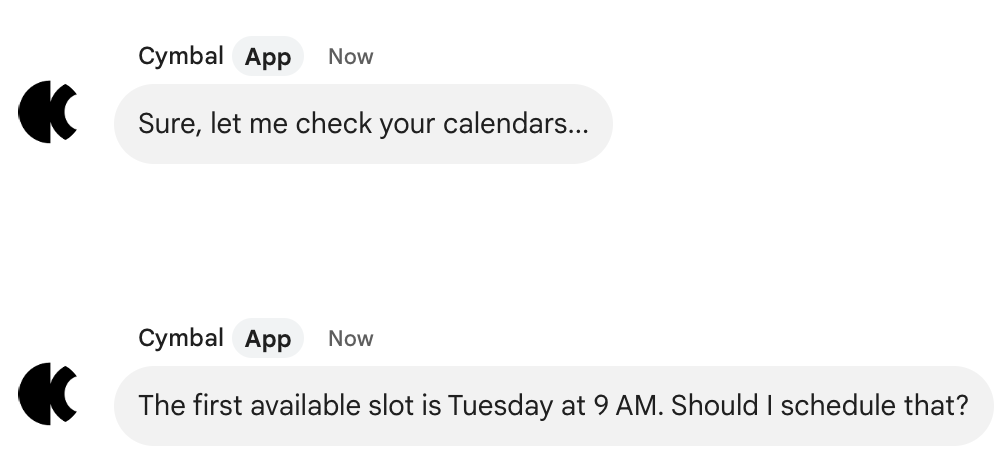本頁面說明設計 Google Chat 擴充應用程式時,如何考量使用者的需求。無論您的 Chat 擴充應用程式支援全球各地成千上萬的團隊,還是只有一個人,請務必在設計過程中納入目標使用者,確保 Chat 擴充應用程式能協助所有傳送訊息的使用者。
探索 Chat 應用程式
請考慮目標使用者首次發現 Chat 應用程式的位置。發布 Chat 應用程式時,請考慮使用者可以在哪裡找到該應用程式。
舉例來說,請勿假設使用者瞭解您的即時通訊應用程式功能。請確保 Chat 應用程式名稱如實反映實際功能,或整合的服務。
熟悉 Chat 應用程式
使用者可能從未與 Chat 應用程式互動,您的應用程式或許是他們的第一個體驗。請勿假設使用者瞭解 Chat 應用程式的運作方式。部分使用者可能會對Chat 應用程式指令和對話方塊等功能感到困惑,因此請提供相關操作說明。
舉例來說,提示使用者發出斜線指令時,建議採用以下格式:

這項提示有以下好處:
- 明確告知使用者需要輸入的內容。
- 使用特殊格式,讓
/createContact斜線指令在周圍文字中脫穎而出。 - 說明斜線指令的目標。
如要進一步瞭解如何透過其他互動式 Chat 應用程式功能協助使用者,請參閱「設計使用者互動」。
地理位置
瞭解世界各地使用者使用 Chat 應用程式的情況。通常,Chat 空間中的使用者遍布全球,因此工作時區各不相同。如果 Chat 應用程式會傳送通知給使用者或聊天室,請注意傳送時間。
舉例來說,下列 Chat 應用程式會通知當週的待命審查員。但如果部分團隊成員位於紐約,部分位於加州,建議您將 Chat 應用程式設定為在所有使用者方便的時間傳送訊息。

如果 Chat 應用程式直接提及使用者,建議先在 Calendar API 中查看該使用者的時區,再傳送通知。如果該使用者不在工作時間內,請考慮傳送訊息時不要提及對方,或是等到對方開始工作再傳送。

語言
Chat 應用程式可以多種語言回覆使用者。如要支援多種語言,Chat 應用程式必須檢查使用者的偏好語言,並據此本地化內容。
如果是 Chat 聊天室,請在 Chat 應用程式的設定中新增語言選項。使用者在聊天室中設定語言後,Chat 應用程式就能以聊天室偏好的語言回覆訊息。
如要查看使用者的偏好語言,請按照下列步驟操作:
- 在 Google Chat API 中,從
User型別取得User.name。 - 在 Directory API 中,將
User.name對應至user.id。 - 在 Directory API 中,取得指定
user.id的user.languages[]。
平台:網頁版與行動版
Google Chat 支援電腦和行動裝置。電腦提供充足的螢幕空間,使用者可能較能接受資訊密集的訊息,以及大量的按鈕和選項。在行動裝置上,由於螢幕空間有限,使用者偏好簡潔的訊息。
每張資訊卡最多顯示三個按鈕。如果需要更多,建議改為啟動對話。對話方塊可顯示一系列資訊卡,讓使用者輸入大量資訊時,體驗比單一資訊卡訊息更友善。
在各種大小的裝置上測試 Chat 應用程式,確保資訊呈現方式易於理解。
語氣
由於 Chat 應用程式是文字介面,因此撰寫清楚、簡潔且可執行的訊息,有助於使用者順利完成工作。為 Chat 應用程式撰寫訊息時,請參閱 Google Material Design 撰寫指南。
每個 Chat 應用程式都不盡相同,但如要與 Chat 使用者有效溝通,Chat 應用程式的語氣和風格應傳達下列特徵:
專業。您的 Chat 應用程式可能正在協助工作場所的同事。請確認其個性符合專業環境,否則可能會顯得突兀或不適當。
真實:即時通訊應用程式可以說口語,但不應假裝是人類。請勿為 Chat 應用程式設定性別,或可能與真人混淆的名稱。加入一點個性是好事,但 Chat 應用程式應著重於實用性。

體貼。請謹慎行事,避免侵入性行為。Chat 應用程式不應不必要或重複打擾使用者。盡量預測使用者需求並提供解決方案。

效率出眾。請瞭解大多數使用者並非想進行長時間的對話。讓使用者專心完成工作。避免說出所有內容,只說最重要的事。如果需要傳達大量資訊,請將長訊息分成多則短訊息。盡量在每則訊息中只加入一個號召性用語,並提供盡可能相關的資訊。

鼓勵。在使用者探索 Chat 應用程式時,請保持樂觀友善的態度。使用者應隨時知道如何朝目標前進,尤其是在遇到錯誤時,例如要求 Chat 應用程式執行無法執行的動作。誠實告知使用者發生錯誤或遇到限制,並說明如何繼續操作。

具有不同權限、角色和資料存取權的使用者
在 Google Workspace 和其他系統中,Google Chat 使用者擁有不同的權限和資料存取權。單一 Chat 聊天室可包含管理員、經理、銷售人員和客戶。以下是在建構 Chat 應用程式時,需要考量的權限相關情境:
無法存取部分 Chat 應用程式
Google Workspace 管理員可以限制哪些人能在 Google Chat 中使用 Chat 應用程式。詳情請參閱 Google Workspace Marketplace 說明文件中的「判斷應用程式的目標對象」。
驗證
提示客戶驗證客戶的 Google Workspace 網域可能無法運作,而且可能會讓使用者感到困惑和沮喪。請撰寫可執行的錯誤訊息,以因應這種可能性。
在 Chat 聊天室中分享私密資訊
如果使用者驗證 Chat 應用程式,以便分享財務或健康資料等私密資訊,建議將該 Chat 應用程式限制為只能傳送 1:1 的即時訊息,以免 Chat 應用程式在其他使用者可能看到的 Chat 聊天室中,意外揭露私密資訊。在 Google Cloud 控制台中設定這類 Chat 應用程式時,請務必在「設定」頁面中,取消勾選「加入聊天室和群組對話」核取方塊。
在包含顧客的 Chat 聊天室中分享資訊
公司員工通常會與客戶共用 Chat 聊天室。Chat 應用程式可大幅提升員工與顧客的互動體驗,但如果 Chat 應用程式與顧客共用聊天室,請務必考量 Chat 應用程式可能會揭露哪些資料。
舉例來說,假設 Chat 應用程式分享了客戶案件的詳細資料。如果 Chat 應用程式在與其他客戶共用的 Chat 聊天室中分享客戶案件,可能會不慎向不應查看的對象揭露客戶資訊。
